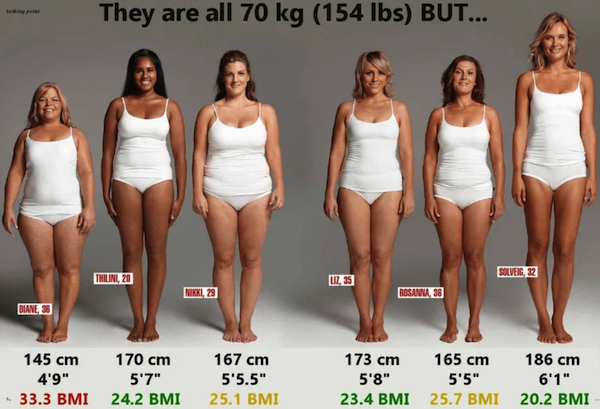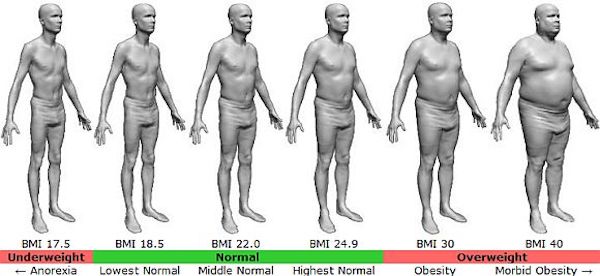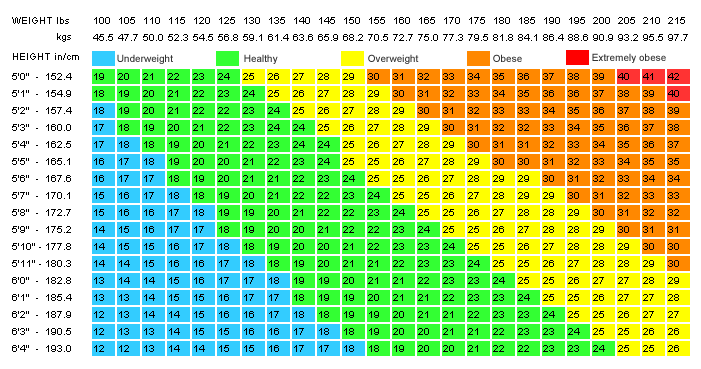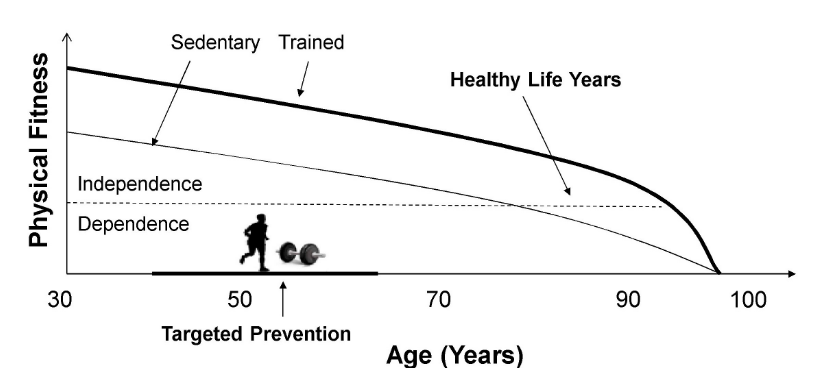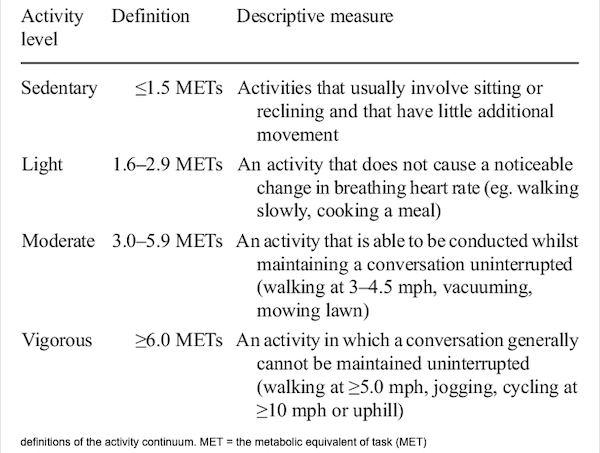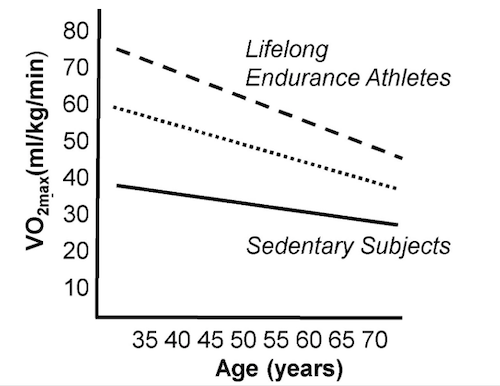How To Reduce Obesity In Older Adults and Improve VO2 Max
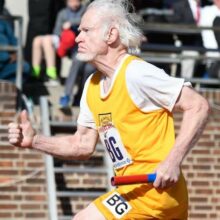
To reduce obesity in older adults requires more than caloric restriction — it usually necessitates aerobic and resistance training. Increase your METs and VO2 max to improve both your body composition and your healthspan.
If asked how to reduce obesity in older adults, perhaps the first answer that would pop into your mind is to reduce caloric consumption. Makes sense — all other things being equal — if you consume fewer calories than you expend to keep your body alive then you’ll lose weight, right?
Yes, if calories in < calories out, you should lose weight, unless you have gherlin, insulin and/or leptin resistance. Or in less you’re getting long in the tooth.

Did you know that the phrase “long in the tooth” is believed to originate from a horse’s teeth, because the older horses become, the longer their teeth get.
A lot changes when we get older, and that includes the ability to lose weight by caloric restriction alone, which is the topic addressed in a study published in September of 2022 that poised the question: “Weight strategy in older adults with obesity: calorie restriction or not?”
Here’s the fast answer:
Probably not.
There are several reasons for this answer, among them, these:
- As we get older, we become more sedentary
- As we get older, we lose muscle and gain fat
- As we get older, our metabolism changes (for the first two reasons)
I’m going to summarize several recent studies to support each of these reasons that address why caloric reduction is typically insufficient to reduce obesity in older adults all by itself.
Content
Let’s dig in…
Why Caloric Restriction Is Unlikely To Reduce Obesity In Older Adults
The aforementioned 2022 study is the first one I want to review with you. It examines caloric restriction in older adults and concludes:
We conclude that calorie restriction among older adults with obesity should be prescribed in combination with both aerobic and resistance exercise to maximize benefits on overall health.
The study asserts that without both aerobic and resistance training (calisthenics and/or weight lifting) older folk are unlikely to shed the pounds. Who among us do not have some poundage to offload!
Are you an overweight or obese older person?
According to the Health Policy Institute, nearly 40% of Americans age 51 and older are overweight. (I’d be surprised if the stats are much different elsewhere in the industrialized world.) Like obesity, being overweight is considered a risk factor for many chronic diseases, such as four of the ten leading causes of death in the U.S. — coronary heart disease, type II diabetes, stroke and several forms of cancer.
So, now you might be asking yourself, Am I overweight and “older”?
The second part of that question is easily answered: If you’re 51 or older, you’re in the category of “older person” that was evaluated by the Health Policy Institute, which used Body Mass Index (BMI) to screen and monitor the risk of obesity.
The first part of the question requires some self-effacement: are you or are you not overweight or obese? To answer that question, consider your BMI.
Which pic resembles you?
I couldn’t find real-life examples for men, so this will have to do:
An overweight adult is one whose BMI is greater than or equal to 25 and less than 30 (unless you have more muscle than average). For example, an adult who is 5’6″ and weighs between 155 and 185 pounds is overweight, and obese if weighing more than 185 pounds.
Go ahead and calculate your BMI using this widget:
Note: BMI is a worthless measure of body composition if you have above average muscle.
OK, now that you’ve got a sense for where you stand on the lean to obesity range, let’s review why eating less all by itself is not the way to lose body fat for older adults.
Why exercise is essential to reduce obesity in older adults
The 2020 study, Weight strategy in older adults with obesity: calorie restriction or not?, cites three reasons that to reduce obesity in older adults they must do more than restrict calories:
- Resistance exercise is needed to improve muscle protein synthesis (using protein to grow muscle) in order to prevent the calorie restriction-induced reduction in muscle and bone mass.
- Aerobic exercise is needed to improve cardiorespiratory fitness and cognitive function.
- Both resistance and aerobic training in combination with caloric restriction provides the greatest improvements in muscle cell quality, frailty, and cardiometabolic* and cognitive outcomes, translating into the greatest improvement in quality of life.
*Cardiometabolic disease describes a spectrum of conditions beginning with insulin resistance, progressing to metabolic syndrome, pre-diabetes, and finally to more severe conditions including cardiovascular disease and type 2 diabetes.
Although the study did not specifically address metabolism, I think a big reason why caloric reduction is insufficient to appreciably reduce body weight in older adults is because of how our metabolism tends to change as we age.
Yes, in effect, our metabolism is perceived to “slow down”, but this too was studied and found to be untrue. Instead, what happens as we get older is that we lose lean body mass; meaning, less muscle and more fat. Partly this happens because we become more sedentary, but continue to consume the same amount of calories. But it isn’t strictly a “calories in vs calories out” dynamic, because of the way calories are used by the body: burned, excreted, or turned into body mass.
The bottom line is that no matter our age, we need to exercise!
Improve METS and VO2 Max To Reduce Obesity In Older Adults and Improve Healthspan
So now you know that consuming fewer calories usually doesn’t lead to a new, slim version of yourself. You need to do more than restrict calories to tackle being overweight or obese as you get older. You need to move weight (yourself or something else heavier than a toothbrush), and move yourself (an activity that makes you a bit breathless for a while).
You need to get fit.
A good way to measure cardiovascular or cardiorespiratory fitness is by VO2 max, a measure of maximal oxygen uptake. Our second study to review is Survival of the fittest: VO2 max, a key predictor of longevity? (abstract, pdf), and it tells us:
VO2max is related to functional capacity and human performance, and has been shown to be a strong and independent predictor of all-cause and disease-specific mortality.
It’s unknown whether maintaining a high VO2max can extend lifespan, but it can “give the years more life”, which is often referred to as enhanced healthspan.
This graph from study #2 indicates how physical fitness relates to healthspan (“healthy life years”):
You can see from the above graph that you can expect a sedentary lifestyle to cause a lack of independence (below the dotted line) at about age 80; whereas a trained individual will pretty much stay healthy until the day (s)he expires.
The The cut-off values are:
- 17.5. ml/kg/min (5 METs) for aerobic capacity; and
- A grip strength of 30 kg (men)/ 18 kg (women) over age 65.
Grip strength is often used as a proxy for overall strength. Just as BMI is an imperfect metric for body composition, grip strength is not an infallible marker for strength, but it’s easy to measure (if you have a dynamometer) and various studies, like this one, indicate that grip strength was a more powerful predictor of cardiovascular mortality than systolic blood pressure. That study also found grip strength to be associated with all-cause mortality, myocardial infarction and stroke.
METs are the metabolic equivalent of a physical task, so this is a way to get a sense if you’re doing enough aerobic exercise.
Wikipedia says METs is “… the objective measure of the ratio of the rate at which a person expends energy, relative to the mass of that person, while performing some specific physical activity compared to a reference, set by convention at 3.5 mL of oxygen per kilogram per minute, which is roughly equivalent to the energy expended when sitting quietly.”
METs are not easy to calculate, so various charts indicate the number of METs that a particular activity produces, but none that I have seen consider the mass of an individual performing the activity; therefore, I prefer to use as a general guideline the capacity to speak while exercising:
METs Estimated by Breathing Difficulty
OK, so now you know that METs can let you know if you’re exercising enough, but what about assessing your fitness capacity?
This is where VO2 max enters the fray.
As mentioned, VO2 max measures capacity; in this case, a function of your pulse when at rest and at maximum effort. An accurate measurement needs to be done in a lab in order to get the values needed for the VO2max formula:
VO2 = (milliliters of air inhaled per minute)(percentage of oxygen in the air inhaled) / (milliliters of air exhaled per minute)(percentage of oxygen in the air exhaled)
I doubt that you know the maximum milliliters of oxygen you consume in a minute, and neither do most of us, so another formula helps us approximate our VO2max:
VO2 max = 15 x (HRmax/HRrest)
My resting pulse is 50 and by a treadmill test at a recent doctors office my maximum heart rate peaked at 168 (although I think I was encumbered by wearing a Covid mask). So, for me:
VO2 max = 15 x (168/50) = 50
This begs the question, Is a VO2 max of 50 decent for a 66 year-0ld man?
According to Garmin, the health metrics tracking company, a VO2 max of 50 for a 66 year-old man is deemed “Superior” at the 95th percentile, per the chart below:
Frankly, I’m surprised that my score puts me in the 95th percentile for men my age, because my aerobic exercise has been wanting of late, mostly consisted of walking up steep hills. But, despite lacking a robust cardiorespiratory fitness regime, there might be an explanation why my VO2 max is so good for my age, and it is this: My resistance training (weight lifting and calisthenics) is performed at a rapid pace, with multiple exercises performed back-to-back, with little rest taken at any time.
I know from an exercise tracking device I wear (Whoop), that I typically spend between 60 to 80% of my resistance training sessions in a high aerobic to mid anaerobic range (120 to 150 heart beats per minute) over the course of a 40-minute exercise period.
What all this means is that in a single exercise session, I’m combining resistance, anaerobic and aerobic training. Now, that might not be ideal if I was trying to optimize my performance in any one of those three exercise categories, but when done all together I address three of the four legs of overall fitness, the last being mobility, which I do in a separate session.
Clearly, making sure you’re getting in enough METs and striving to improve your VO2 max is going to put you ahead of the pack. The graph below shows how much better is the VO2 max of athletes as compared sedentary people as they all age:
The figure above shows the age-related decline of maximal oxygen uptake (VO 2max) in endurance trained male (- – -) and female (…) athletes versus a sedentary control (─).
VO2 max is affected by the aging process, but it can improve significantly at any age with regular endurance training by approximately 15 to 20%, or 0.5.l/min, depending on exercise intensity. It’s possible that a trained 70-year-old can exhibit the biological age of an untrained 50-year- old based on the VO2max.
One more thing, and it’s a biggie, about the association of VO2 max and longevity brought to you by longevity expert Dr. Peter Attia:
If you didn’t watch Peter’s video, I’ll just put it this way for you:
The lower your VO2 max, the younger you’re likely to kick the bucket.
Let’s now turn to resistance training, because as study #1 asserts (and I repeat):
Both resistance and aerobic training in combination with caloric restriction provides the greatest improvements in muscle cell quality, frailty, and cardiometabolic* and cognitive outcomes, translating into the greatest improvement in quality of life.
Do Resistance Training To Reduce Obesity In Older Adults and Improve Healthspan
Again, the “resistance” part of resistance training refers to resisting some load, be it the weight of your own body, or some external weight or something else (like resistance bands) upon which you must exert force to move.
In case you think you’re too old to move weight around, consider what 81 year-old Sigurd Sandstrom can do:
Or consider what 100 year-old Edith Murway-Traina can do:
I’m not suggesting you run off and lift heavy weights per se. I am however suggesting that what you’re willing to do and can do is largely determined by your mindset. Unless you’re permanently physically incapacitated, you could apply yourself to gradually doing some type of resistance training, along with mobility training, to get stronger and push back against sarcopenia (muscle wasting).
Here’s why you should bother doing resistance training:
- Each decade most of us experience about a six degree decrease in flexibility of the shoulder and hip joints [1].
- Muscle atrophy (sarcopenia) occurs at about one percent per year after age 50 [2]. (Note: this is a compound rate.)
- Resistance training that builds muscle:
- Increases bone density by stressing bones from movement and force patterns of the training [3].
- Increases muscle mass which means more strength, better balance, and an increased metabolism [4].
- Enables better balance and functionality, which makes activities like sitting down in a chair, reaching up to get something from a shelf, or even tying your shoes easier, and these benefits translate into a reduced risk of falls, or other catastrophic injuries [5].
- Improves body composition by increasing muscle and reducing excess body weight [6].
- Improves quality of life, given that people who regularly train often experience improvements in their psychosocial well-being [7].
Unfortunately, there’s no one-size-fits-all program I can recommend that you do. We have to start with where we’re at, and therefore it’s important that you assess your limitations and exercise knowledge before you begin.
If you’ve never done resistance training before, I highly recommend hiring a trainer until you are adept at performing whatever program you and your trainer implement. Especially as we get older and begin to accumulate the aches, pains and limitations — it’s important to get some guidance from an expert. Not to mention encouragement — that can go a long way!
If you’d like a taste of the types of exercise that you could consider, check out my six-part series, The Functionally Fit Fast Workout.
And if you’re in a hurry, try out some exercise snacks.
Questions, comments? Scroll down and have at it in the Comments section.
Last Updated on July 7, 2023 by Joe Garma


